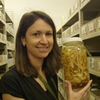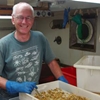General Description
Carapace smooth, not covered with setae. Pseudorostral lobes without carinae. Uropod rami shorter than uropod peduncle; uropod endopod triarticulate in both sexes. Body length females up to 2.4 mm, males up to 2.8 mm.
Biology
Gynodiastylis pygmaeoinsolitaseta is named from a combination of Latin terms that describe the animal: pygmaeus, meaning dwarf, insolitus, meaning unusual or odd and setus in reference to the setae (hairs) on the tail fan.
Habitat
Soft bottoms, at depths of 2-188 m.
Soft substrates
Distribution guide
Southern temperate oceans, including south-eastern Australia.
Species Group
Depth
Shallow (1-30 m)
Deep ( > 30 m)
Water Column
Max Size
3 mm
Diet
Organic matter
Commercial Species
No
Global Dispersal
Native to Australia
Species Code
MoV 89
Conservation Status
- DSE Advisory List : Not listed
- EPBC Act 1999 : Not listed
- IUCN Red List : Not listed







